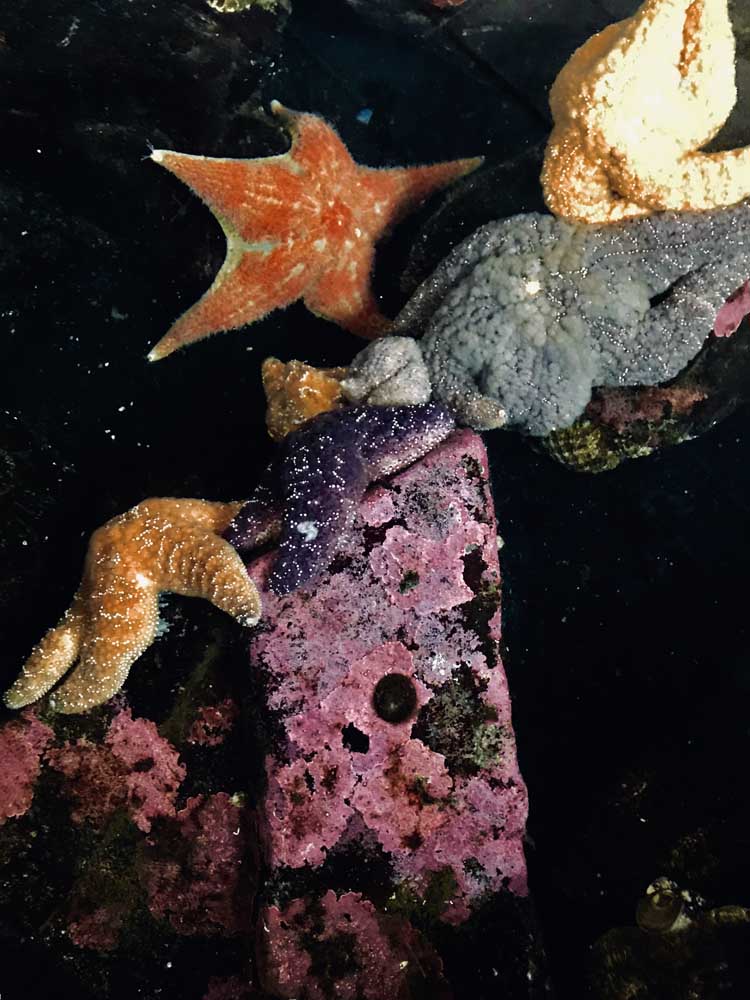Close to home: Science center in Sitka provides window into marine life’s future
Published 12:00 am Saturday, July 13, 2019

- Starfish at the Sitka Sound Science Center.
Salmon are the heartbeat of Alaska, as they are for the familiar communities of Astoria and Warrenton, Ilwaco and Chinook. They travel as far upriver as an eagle’s far-reaching eyes can see, all 1,400 miles, always unraveling the way water travels, by tide and currents and the grace of an undefinable but ever-present force.
Trending
Historic salmon runs were estimated in the tens of millions. Last year, the Big River netted less than a million. Alaska has done far better with its network of hundreds of well-healed rivers, though 2018 was a bust in a number of salmon towns. Herring runs fell dramatically. Fish are dependent on a healthy food chain. More recently, that biological reality appears in some jeopardy.
“If you blame someone else, there is no end to the blame,” so said Lao Tzu 400 years before Christ. But there does seem to be plenty of finger-pointing to go around. Some say the decline in fish runs is due mainly to predators: sea lions and seals, Caspian terns, cormorants and even seagulls. In Alaska, a grizzly or brown bear can devour dozens of salmon a day. That makes for great photographs but unfortunately adds up to big numbers of depleted fish.
It is sad to say that human beings share a major part of this story. Once again we are passing around blame, but the fingers are pointing at ourselves. The number of dams on the Columbia and Snake rivers loom large. Deep in the coastal range, riparian zone destruction remains a visible reminder of our once old growth forests. Historically, flora and fauna were ripped from steep hillsides after man-built splash dams were dynamited and huge evergreens careened down the streams, tearing and slashing on their descent to larger water. Subsequently, winter rains buried salmon smolts under layers of unctuous mud after the forests were denuded.
Trending
In Naselle and on the Nemah River in Pacific County, modern-day hatcheries supply our fishing waters with chum, silver and Chinook salmon. In Chinook, the oldest hatchery in the Northwest is gearing up again after a decade long sojourn.
In Alaska, these hatchery programs spread across the state.
On Baranof Island, there are five hatcheries that produce hundreds of millions of 6-inch fry. Five percent return as mature salmon. Until last year, the industry had grown back to numbers that reminded old timers of earlier salmon booms. One hatchery in particular, the Sitka Sound Science Center, has drawn a lot of attention.
Researchers from Portland State University, the University of California, Santa Cruz and others gather here. Even the Coast Guard pitches in. The Sitka National Historical Park is intertwined into the program. Under study: kelp forests, subtidal surveys, salmon and rockfish observations, biological monitoring and studies of ocean acidification, just to mention a few.
Though small, the center features a sweetheart aquarium open all year to the public. This is a visit into the subtidal world of underwater plants, fish and organisms that inundate these coastal waters. Good science is the key. Outreach manager, Sandy McClung, seems apprised on every aspect regarding regional and global environmental events. Her eyes and ears are glued to our children’s future. This science center captivates the imagination.
Protecting natural resources is a game we can win, McClung said. And she has answers. To add a slight twist to Henry David Thoreau, “in science lies the preservation of the planet.”
The Sitka Sound Science Center takes ocean and river science to the classroom, beginning with kindergarten and expanding through high school. The guiding force is simple enough: Get the kids involved. Share with them the penetrating aspects of a changing world. Pique their interest now, and you will set a moveable standard.
Washington state’s governor knows. Breed salmon, he says. He is now pulling dollars from state funds for that very purpose. Say what you wish, but Jay Inslee is on a binge to save the planet. As a candidate for president of the United States, he has put, as his single pressing issue, a plan to fight global warming.
Meanwhile Sitka (Sheet’ka) gallops along. The boats come in daily with loads of bright fat salmon, huge halibut and white fish, like lingcod or sable fish. Tourists flock to this lovely city on the water. They catch the fish. They eat the fish. Does this remind you of home?








